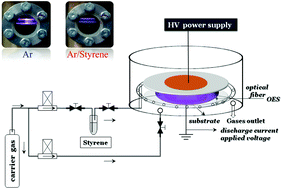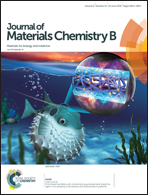Aqueous medium-induced micropore formation in plasma polymerized polystyrene: an effective route to inhibit bacteria adhesion†
Abstract
Plasma polymerized styrene (pPS) films were successfully synthesized by means of an atmospheric pressure plasma technique, using a mixture of argon gas and styrene vapor. The morphology and film thickness of the pPS films, deposited on 1 min argon plasma pre-treated glass substrates, were smooth and uniform without any visible features across the whole length of the substrates, and the films displayed a water contact angle of ∼83°. X-ray photoelectron spectroscopy (XPS) and Fourier transform infrared (FTIR) analysis confirmed the presence of oxygen-containing groups and the intact aromatic ring in the pPS coating. The obtained pPS films were stable for at least 30 days in air without any visible morphological degradation or chemical changes. However, the formation of a topographical pattern with micrometer lateral size and nanometer depth level was observed upon immersion in aqueous media for 72 hours. Micropore formation was believed to originate from the solubility of low cross-linked oligomers and their subsequent extraction in aqueous media. The influence of the microstructured pPS surface in mediating the attachment of eukaryotic and prokaryotic cells was further investigated. The micro-structured pPS surface influenced the adhesion and proliferation of mammalian cells. Furthermore, we could demonstrate that these films were efficient in the prevention of Gram-negative Escherichia coli (E. coli) and Gram-positive Staphylococcus epidermidis (S. epidermis) adhesion and biofilm formation. Importantly, the viability of non-adherent cells and of planktonic bacteria was not affected. Post-coating of the microstructured pPS with biocompatible polydopamine did not impact on the antibacterial properties of the surface, suggesting that the polymer topography was the dominant factor. The non-biocidal pPS coating can be useful in applications where micro-organism colonization and biofilm formation need to be prevented, such as food packaging and medical equipment.



 Please wait while we load your content...
Please wait while we load your content...